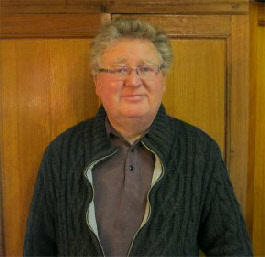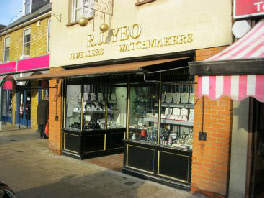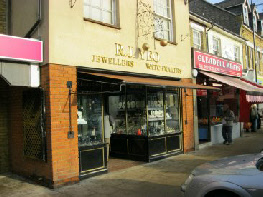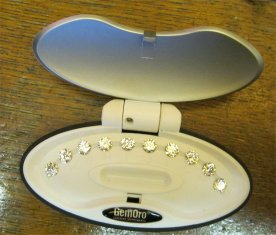Talk to us here at Rochford Life : 0786 342 7294 or E-mail us. For other numbers see individual pages.


Make a point of visiting us weekly! Tell a friend about us.
The Square - “R.J.Yeo”
Jewellers & Watchmakers
Jewellers & Watchmakers
Kenneth J Massow FIRV FGA DGA
R J Yeo
24 West Street, ROCHFORD, SS4 1AJ
Tel: 01702 544712
ken-john.massow@virgin.net
R J Yeo
24 West Street, ROCHFORD, SS4 1AJ
Tel: 01702 544712
ken-
Part 4: Introduction to DIAMONDS
RL: How about diamonds?
Ken: We have treatments done to diamonds and nowadays you can actually buy laboratory grown diamonds. Fortunately at the moment they can all be detected. There has to be a difference between something grown in a laboratory in a few months and something that has taken millions of years to form in the earth and there are differences that still show up. The actual production process for synthetic diamonds is extremely expensive and up until very recently the only commercially viable colours have been yellows, blues, greens and pinks and you will see many coloured diamonds now offered for sale at very low prices and this is because the colour is either enhanced from a natural diamond or it is a synthetically grown diamond that is coloured and the colour is a by-product of the production process
RL: I need to confess my ignorance here. I thought diamonds were just diamonds and didn’t realise they were coloured.
Ken: No, as diamonds form in the crystal structure, all the particles lock together in a very tight formation which is what makes it such a hard material. Within the corners of the lattice structure of the crystal you can get little pockets of different materials which will produce a different colour within the stone. Now I’d be the first to admit I’ve never really understood the term blue-white but blue-white is agreed to be a higher quality white than just plain white as perceived by the human eye. Looked at by a different eye it would appear a different colour but with the human eye it is considered more white. That is purely the influence of different chemicals seeping into the crystal structure and producing slightly different colours. Now anything other than a pure white – we go from a blue-white to white to yellow to yellow-brown to brown. That is the normal white series of diamonds going through that sequence.
RL: Would you with the human eye notice these different colours? Are they very distinctive?
(At this point Ken produced a box only slightly larger than a spectacles case [see side picture] in which were displayed – to my eye at least – ten identical diamonds - OK the right hand end one seemed slightly more yellow to me)
Ken: I know what I am looking at but I can’t tell you what other people are looking at. This is actually a colour grading set; it’s a very expensive tool. This is going from colour E to colour N. Your very best colour is D to F and we go down to Z but this only going from E to N. N would be considered quite a bad colour.
This is something that requires training. Most people can see the yellow-brown series. There are various price guides in the industry that go through the colours, the purer white being the most expensive. Over the years I have undergone colour tests and you are given 360 colours and you have to arrange them in order of 360 hues. The last one I took I got four pieces wrong and that is considered quite good.
RL: If I took one out of this colour grading set without you seeing and showed it to you, would you be able to tell me where it was in the set?
Ken: Oh yes. When I was taught diamond grading I was given a pure white piece of paper and you are taught with known colour stones to compare the stone against the white piece of paper.
When we are diamond grading we would normally compare them under what is called a diamond light – it’s a light that projects light that is similar to that of a normal light; no sunlight, just a bright day with no sunlight. A diamond light produces that neutral colour – so there is no influence of colour from outside light.
I don’t know if you are aware that everything in the world is black and white and the eye turns it into colour, so colour is perceived in very different ways by different people. Although a lot of people may not be colour blind, they may still have colour bias so they may see more red or more blue or more green and so, within the gem-testing trade, we conduct sight colour tests. That way if you know that when you are looking at green you have a yellow bias, and you find yourself thinking, “This isn’t such a good quality emerald because it draws a yellow colour,” you know that if you are seeing twenty grades away, then you correct for your own eyesight.
Because I am a registered valuer I do such a test every two or three years. We all have to go to Loughborough University for a very long weekend and one of the things you can elect to do, which I always do, is have your eyes tested for colour, simply to know if I am getting deviation.
From the diamond price lists we can see that with variation in colour there is quite dramatic variation in price, so it is quite important that you get the price where it is supposed to be. We use a set of master stones to actually check your eyes are not going off colour and every so often – more so with larger stones because the price difference is much larger on bigger stones – the colour grading set comes out and I check my original result against what the master set would say.
RL: May I ask a question without wanting to give offence. Suppose a wealthy but average unknowing person wants to buy a diamond, say for their wife, and they come in, surely they cannot see the differences between all these diamonds, so I understand why it may be important for those in the trade, but what about the ordinary person?
(To answer my query Ken had two 1 carat diamond rings taken out of the window – one marked at £10,000 (!!!!) and the other at about a thousand. I don’t believe it was psychological but the more expensive one sparkled and had a clarity that left the other almost looking dull. Why buy the £1000 ring? Presumably because you have the money and want to spend it and know you have a [relatively] expensive ring!!)
Ken: You can get better than that more expensive one but we find stones better than that difficult to sell anyway, because a lot of the public don’t appreciate the difference. This less expensive one is relatively poor quality. The thing with diamonds is not to confuse quality with value. Even a stone of poor quality can be worth thousands and thousands because you still have the size. (At which point I am shown another ring which is big!) Yes, this is 2.87 carats. It’s not high quality in that sense but it is big so the ‘big’ if you like is the plus point (This particular ring also had a particularly intricate and beautiful old setting – another influence on value!)
(Forgive me if you have become really interested but by this time my mind was whirling with information and so, for the time being, decided to call it a day - and when you’ve studied a ten thousand pound beautiful diamond ring, everything else is a bit of an anticlimax!)
RL: Well, thank you Ken, I really do appreciate the time and explanations you have given me. It has opened up a completely new world. Perhaps in the new year I can come back and learn some more. I think for the time being you have given readers of Rochford Life more than enough to think about. Thank you so much again.
Top of Page
RL: How about diamonds?
Ken: We have treatments done to diamonds and nowadays you can actually buy laboratory grown diamonds. Fortunately at the moment they can all be detected. There has to be a difference between something grown in a laboratory in a few months and something that has taken millions of years to form in the earth and there are differences that still show up. The actual production process for synthetic diamonds is extremely expensive and up until very recently the only commercially viable colours have been yellows, blues, greens and pinks and you will see many coloured diamonds now offered for sale at very low prices and this is because the colour is either enhanced from a natural diamond or it is a synthetically grown diamond that is coloured and the colour is a by-
RL: I need to confess my ignorance here. I thought diamonds were just diamonds and didn’t realise they were coloured.
Ken: No, as diamonds form in the crystal structure, all the particles lock together in a very tight formation which is what makes it such a hard material. Within the corners of the lattice structure of the crystal you can get little pockets of different materials which will produce a different colour within the stone. Now I’d be the first to admit I’ve never really understood the term blue-
RL: Would you with the human eye notice these different colours? Are they very distinctive?
(At this point Ken produced a box only slightly larger than a spectacles case [see side picture] in which were displayed – to my eye at least – ten identical diamonds -
This is something that requires training. Most people can see the yellow-
RL: If I took one out of this colour grading set without you seeing and showed it to you, would you be able to tell me where it was in the set?
Ken: Oh yes. When I was taught diamond grading I was given a pure white piece of paper and you are taught with known colour stones to compare the stone against the white piece of paper.
When we are diamond grading we would normally compare them under what is called a diamond light – it’s a light that projects light that is similar to that of a normal light; no sunlight, just a bright day with no sunlight. A diamond light produces that neutral colour – so there is no influence of colour from outside light.
I don’t know if you are aware that everything in the world is black and white and the eye turns it into colour, so colour is perceived in very different ways by different people. Although a lot of people may not be colour blind, they may still have colour bias so they may see more red or more blue or more green and so, within the gem-
From the diamond price lists we can see that with variation in colour there is quite dramatic variation in price, so it is quite important that you get the price where it is supposed to be. We use a set of master stones to actually check your eyes are not going off colour and every so often – more so with larger stones because the price difference is much larger on bigger stones – the colour grading set comes out and I check my original result against what the master set would say.
RL: May I ask a question without wanting to give offence. Suppose a wealthy but average unknowing person wants to buy a diamond, say for their wife, and they come in, surely they cannot see the differences between all these diamonds, so I understand why it may be important for those in the trade, but what about the ordinary person?
(To answer my query Ken had two 1 carat diamond rings taken out of the window – one marked at £10,000 (!!!!) and the other at about a thousand. I don’t believe it was psychological but the more expensive one sparkled and had a clarity that left the other almost looking dull. Why buy the £1000 ring? Presumably because you have the money and want to spend it and know you have a [relatively] expensive ring!!)
Ken: You can get better than that more expensive one but we find stones better than that difficult to sell anyway, because a lot of the public don’t appreciate the difference. This less expensive one is relatively poor quality. The thing with diamonds is not to confuse quality with value. Even a stone of poor quality can be worth thousands and thousands because you still have the size. (At which point I am shown another ring which is big!) Yes, this is 2.87 carats. It’s not high quality in that sense but it is big so the ‘big’ if you like is the plus point (This particular ring also had a particularly intricate and beautiful old setting – another influence on value!)
(Forgive me if you have become really interested but by this time my mind was whirling with information and so, for the time being, decided to call it a day -
RL: Well, thank you Ken, I really do appreciate the time and explanations you have given me. It has opened up a completely new world. Perhaps in the new year I can come back and learn some more. I think for the time being you have given readers of Rochford Life more than enough to think about. Thank you so much again.
Top of Page




Continuation of Interview with Ken Massow (Part 4)
As we continued to talk on with Ken we then moved on to talking about Diamonds. Again, we hope this introduction will whet your appetite to find out more using your own web-browser & favourite search engine, Have fun . (This part was seriously hands on, an amazing experience!)